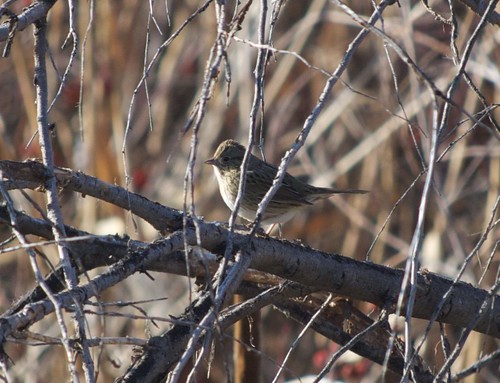 |
| Guillaume Peron broadcasts owl calls in the cold pre-dawn of Green Canyon. |
By the end of the day, the count collectively had tallied over 16,000 individuals of 92 species. That is at the low end of our averages, but given that fog hung over the valley for most of the morning, we felt pretty happy with that total. A more thorough analysis of the numbers of each species will be published in the next edition of the Bridgerland Audubon Society's newsletter, the Stilt, but here are some of the rarest species reported:
CACKLING GOOSE - Five individuals seen in a flock of 300+ Canada Geese at the Logan River Golf Course by me and Guillaume. This species was only split from Canada Goose in 2004, so most previous CBC'ers didn't try to count them. First documented in our count in 2008, seen again in 2009, and missed last year.
 |
| A Richardson's subspecies of Cackling Goose among Canada Geese at the Logan River Golf Course. |
DOUBLE-CRESTED CORMORANT - One bird with an injured wing has been hanging out at the Logan Fisheries Experiment Station ponds for several weeks. This species has only been seen on our count on three occasions in the last 20 years.
WHITE-FACED IBIS - Three individuals were seen by several counters. Only one observation on our CBC in the last 20 years.
HOODED MERGANSER - Two females or immatures continuing at First Dam, seen by several observers. Seen about every other year on count day.
HERMIT THRUSH - One individual seen by me and Guillaume, but no photos. Found on our CBC about one out of every two years.
BEWICK'S WREN - One possible observation of this species was reported by Reinhard Jockel and Caitlin Laughlin. Craig Fosdick and I were not able to relocate this bird today. This species has never before been reported on our CBC since the count started in 1956, and will probably require additional documentation to be included in the final totals.
LINCOLN'S SPARROW - Two of this species were observed, which is quite remarkable since it has never been seen on our count before. One was a continuing bird found last week by Andy Kleinhesselink and relocated by Bryan Dixon and Jean Lown. The second was found and photographed by Kurt Kotter.
 |
| Lincoln's Sparrow photographed Dec 9 by Andy Kleinhesselink, linked from his Flickr account. This bird was relocated on the Logan CBC. |
WHITE-THROATED SPARROW - Another great find, continuing from Andy Kleinhesselink's discovery last week. Always a good one to look for on our CBC, found on 7 of the last 20 counts.
 |
| I photographed this White-throated Sparrow on Dec 10, but it was relocated on count day. |
(RED) FOX SPARROW - Found by Guillaume Peron and me. Fox Sparrows have been reported on only four Logan CBCs since the count started in 1956, and once in the last 20 years. The CBC doesn't typically record subspecies, so I don't know whether those previous observations were of the subspecies that breeds here, the Slate-colored Fox Sparrow, or vagrants of another subspecies. The Red Fox Sparrow breeds in northern Canada and the eastern states. According to eBird, the Red subspecies has only been documented in Utah once before. (There are a few other reports that I know of that are not in eBird). There is some indication that this group might get split in the future, elevating the Red Fox Sparrow to full species status, and some authors already consider them to be a separate species. Dennis Welker reported that he also thought he had a Fox Sparrow at Spring Hollow, but it wasn't clear to me whether he considered that observation confident enough to count, and he didn't know which subspecies it was.
Finally, I found two very interesting ducks at the Logan Sewage Lagoons, neither of which really "count" as species for the Christmas Bird Count, but they are noteworthy nonetheless. First was a "Brewer's Duck," a hybrid between a Mallard and a Gadwall. (More on Brewer's Duck here.) The second was another hybrid, this time between a Northern Pintail and a Mallard. What a beautiful duck!
 |
| "Brewer's Duck," a hybrid between a Mallard and a Gadwall. |
 |
| One of the prettiest ducks I've seen, a hybrid between a Mallard and a Northern Pintail. I love that long pintail that curls up like a Mallard's tail feathers! |





No comments:
Post a Comment